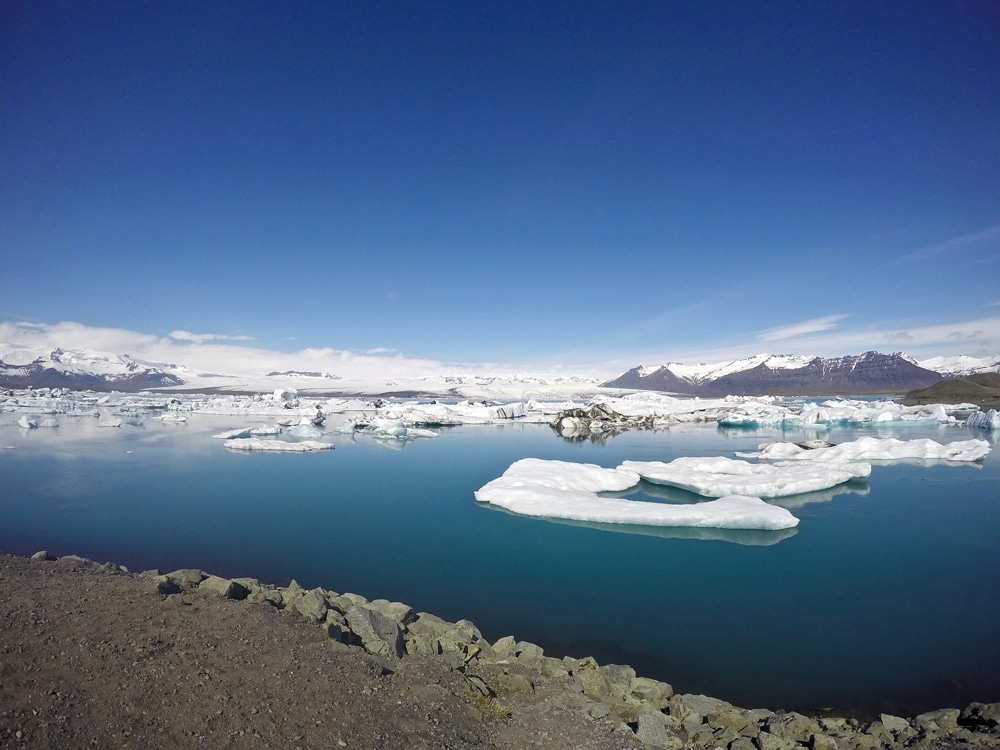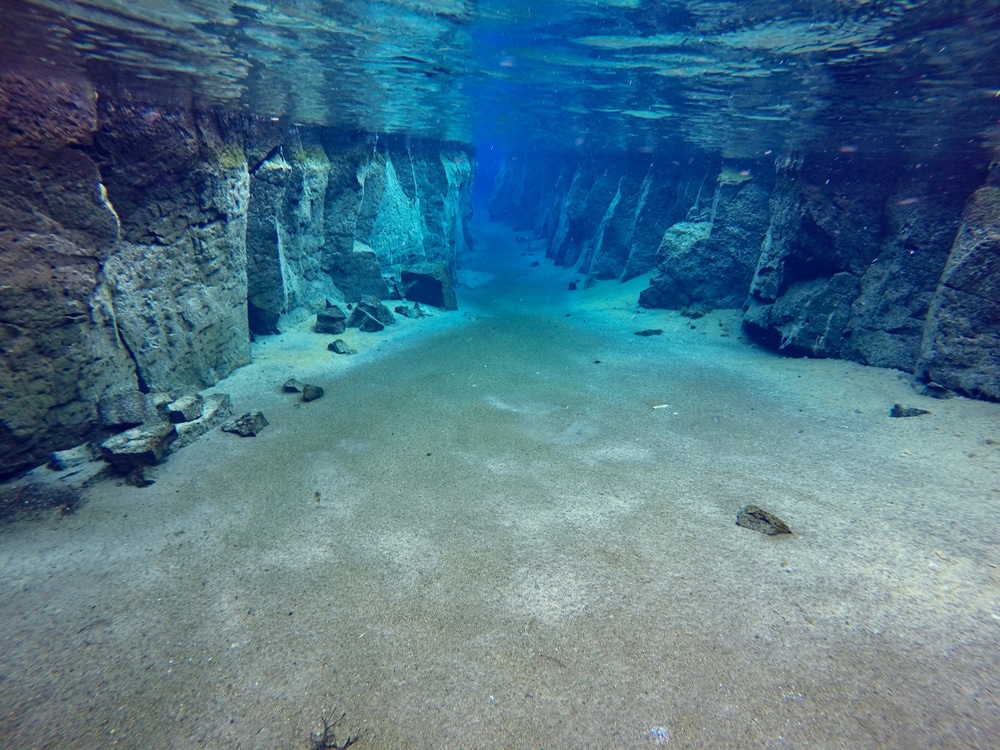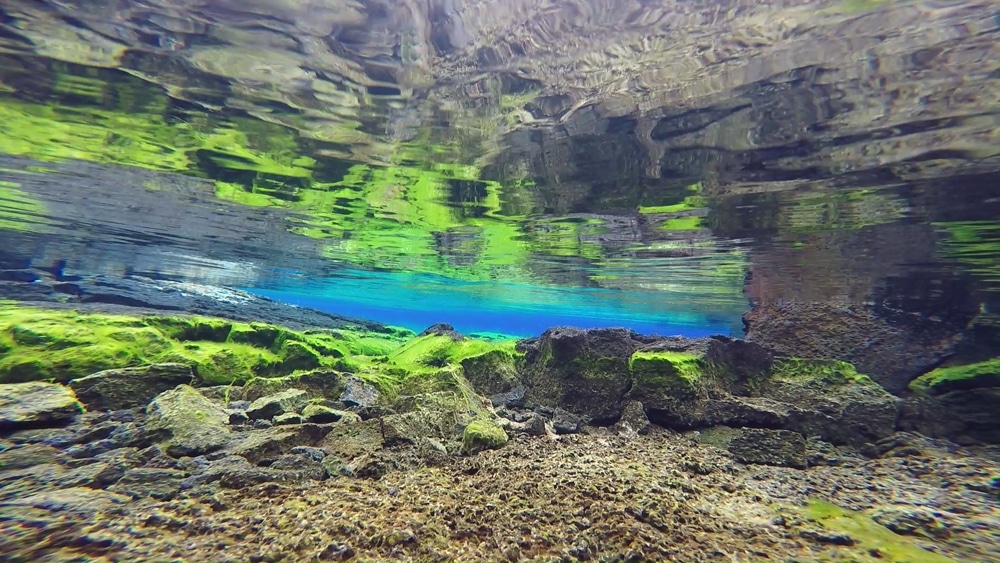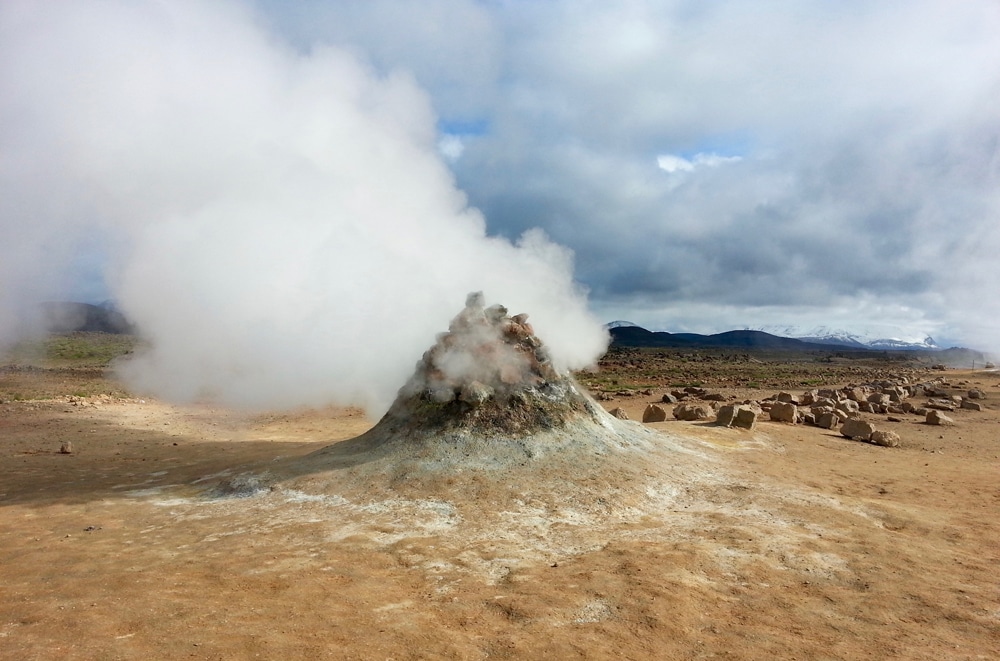News
Iceland: Above the 65th parallel
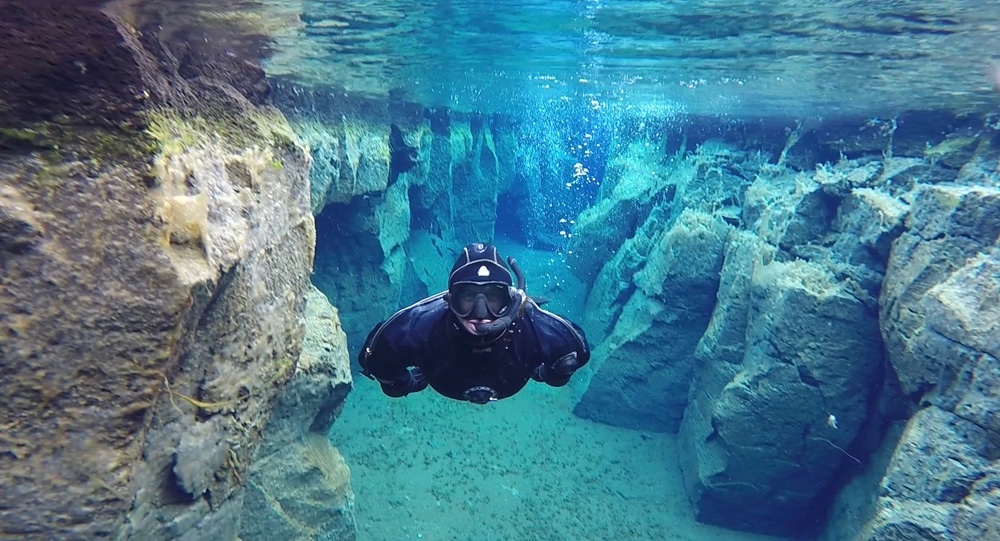
Think of diving in Iceland and one place springs to mind, Silfra. It is by far the most dived site in the country and has become a bucket list dive for many divers, including many who thought they would never be convinced to dive in cold water. It is special and famous for good reason, but there is so much more to diving in Iceland!
Mike and I had the very good fortune to live in iceland for over a year and in that time got to dive many sites a little more off the beaten track. Here, we want to share with you some of our favourite sites in the less explored north of iceland, reached by the very scenic ring road drive along Highway 1.
What if we were to tell you that Silfra is not the only fissure in Iceland between the tectonic plates and filled with clear, blue glacial spring water? There are several in the Reykjavik area, Davidsgja, also in Thingvellir National Park, is a deeper, darker version of Silfra, and Bjarnagjá, on the Reykjanes peninsula,is a crack that connects with the ocean and so you can encounter a neat halocline, at variable depth depending on the tide and see the anemone that lives on the bottom of the crack, they have also just sunk a small wreck in there for added interest.
However there is an equally clear fissure often completely overlooked, chances are you would have the whole fissure to yourself. Meet Silfra’s “little sister”, Nesjá. The Silfra of the North.
Nesjá
About an hour east of Akureyri, Nesjá is a very shallow, water filled fissure a few hundred meters from the side of a small farm road. Be prepared for a bit of an adventure finding this place, a good map and a car are needed to get here! Once parked up you can kit up and walk to the start of the crack and the rocks which can be easily climbed down to access the water. This is a shallow site, less than 5m, and so can easily be snorkelled if you plan on doing any exploring in the highlands later in the day of have a flight to catch. The water is crystal clear, a stunning blue and on a sunny day the light sparkles through the water to create rainbows on the pale silt bottom. The crack runs out towards a lake, which connects to the ocean. It is a very easy dive to navigate, simply follow the crack until you can veer right into the lake, which resembles a tropical lagoon. Save some energy for the swim back as it is against the current, it is not very strong, but still saps some energy as does the 3ºC water temperature.
Now Nesjá isn’t as impressive as Silfra, but it is well worth a splash if you are in the area. It is also conveniently near the very picturesque town of Húsavík, famous for it’s fabulous whale watching and geothermal springs. A very pleasant day can be had, whale watching in the morning, diving or snorkelling Nesjá in the afternoon and bathing in hot springs in the evening, or any combination thereof.
Also in the North, thrusting up the depths in Akureyri Fjord is Strytan. This has to be my favourite ocean dive in Iceland, Strytan is a geothermal underwater chimney!
Strytan
Similar to the well-known “black smokers” found in very deep oceans, but Strytan is at recreationally diveable depth, the top is at 15m and the bottom is at approximately 70m. The dive is only on the top half unless you are tec diving. There’s just one dive center that can take you there (www.strytan.is), run by Erlendur Bogason, the discoverer and official protector of Strytan. He is an expert in the area so you are in excellent hands.
Hot water pours out of vents on this giant spire from numerous vents, around 100l of 72°C freshwater coming from the chimney every second! Strytan was formed over 10000 years ago and apparently the chimney is still building. Aside from the main feature of the chimney, you’ll get to see wolf fish, lots of crustaceans and anemones, and schools of cod are regularly seen There is a second smaller hydrothermal feature nearby known as “Little Strytan”, a small underwater hill made up of smaller chimneys in around 25m. This is often home to more life than Strytan and gives lots of photo opportunities with the very friendly local wolf fish.
If you’re lucky, humpback whales are commonly seen in Akureyri Fjord and usually spotted from shore or while on the dive boat. The dive center had a hot tub by the shore where you can relax and whale watch with an after-dive beer. Perfect!
I really cannot do justice to this site, the experience of diving a hydrothermal feature is incredible and the unique flora a fauna that has settled in this specialized environment is truly something to behold. If there is any dive site in Iceland aside from Silfra that you absolutely have to do, it’s Strytan. Be aware, this is a dive for advanced and drysuit certified divers only. Since 2001, Strýtan has been a protected natural reserve, so good buoyancy is essential to preserve this natural phenomenon.
When not occupied with diving and watching marine mammals, the north also boasts some spectacular sights on land. Akureyri, the capital of the North is situated at the south of a stunning fjord, and boasts good nightlife and Hlidarfjall, the best ski resort in the country. It is a good base and is only around 5 hours from Reykjavik, or a very short flight.
If you like to keep the water theme, the waterfall Godafoss (literally ‘Waterfall of the Gods’) is pretty stunning and is between Akureyri and Myvatn. The Myvatn area is a very special place, both for the huge numbers of geothermal features, hot springs and Lake Myvatn, home to rich birdlife and amazing views on the Northern lights in winter. Next to Myvatn is Dimmuborgir, an area of strange and dramatic rock formations, known as the ‘Gateway to hell’, well worth a quick hike around. You will also see Hverfjall, a near perfect volcanic ash cone and for Game Of Thrones fans, you can visit Grjotagja cave, made famous by Jon Snow and the wildling Ygritte in S3E4.
As with pretty much all of Iceland, there are landscapes in the north to make your jaw drop and lots of excellent hiking, horse riding, extreme sports, friendly locals and good food and drink. It just depends how long you have to explore. Whatever you choose to see and however long your trip is, I’m certain you will want longer and be planning a return trip as soon as the funds allow!
Want to read and see more from CJ and Mike’s Iceland adventures? You can by heading over to read their article in Dive Travel Adventures by clicking here.
News
Book Review: Fire on Monroe Bravo by Fred Lockwood

Fire on Monroe Bravo is the latest book in the Jack Collier series by Fred Lockwood. Our story begins with our lead characters, Jack and Sandro, owners of Marine Salvage & Investigation Company, arriving on the Monroe Bravo Oil & Gas Platform in the North Sea. Having secured a contract for their vessel the MV Stavanger to act as support ship to the platform for TransGlobal Oil, our protagonists are on a celebratory visit.
However almost as soon as they arrive a series of explosions rock the platform, causing huge damage, loss of life and the very real danger of a massive human, ecological and financial disaster.

As the danger mounts for both our heroes and the surviving workers, Jack and Sandro will have to escape the inferno, all while trying to save the platform and the men still trapped unable to help themselves.
The disaster sets the scene for the unfolding story lines following the fate of the platform and our main characters, the police investigation into a suspected terrorist act and the actions of TransGlobal Oil as they attempt to navigate the pubic outcry and financial repercussions.
In his eighth book, Fire on Monroe Bravo, Fred Lockwood delivers an explosive thriller, with plenty of above and in-water drama, and our heroes fighting for survival, what more can you ask for?
We thoroughly recommend this read and look forward to the next in the series. For more information about his book series, you can check out the reviews of his previous books here on Scubaverse.
- Title: Fire On Monroe Bravo
- Author: Fred Lockwood
- ISBN: 979-8325324536
Available in a paperback version and for Kindle from Amazon and book stores.
Blogs
Alonissos: The complete diving destination (Part 1)

In June we were incredibly fortunate to be invited to dive in Alonissos, a small Greek Island in the Sporades island chain located in the North Aegean Sea. While I have long been a big fan of the Greek Islands as a great holiday destination, I had not had the opportunity to do any diving on previous visits and Mike and I were extremely excited to see what Alonissos had to offer both above and below the surface!

The Sporades are easily accessible via the airport in Skiathos (the first island in the chain), which is served by Jet2 flights from all major UK airports from May through October. Numerous ferries and charter boats make island hopping from Skiathos Town a breeze. After an hour boat ride, the picturesque port of Patitiri was a wonderful introduction to Alonissos, where we were met by our gracious hosts Kostas of Albedo Travel and Dias of Alonissos Triton Dive Center. Mike and I were delighted to be staying at the Paradise Hotel, aptly named for its stunning views over the sea and great location for walking to the waterfront.

Alonissos is beautifully situated in the National Marine Park of Alonissos and the Northern Sporades, the largest marine protected area in Europe. The surrounding seas offer fabulous marine life, including incredibly rare species such as the Mediterranean monk seal. They boast deep walls covered in gorgonians and sponges, stunning topography with caverns, swimthroughs and pinnacles, and the first accessible ancient shipwreck from 500BC!

In locations where historical sites have been reported, the waters are largely restricted, but with collaboration between government, underwater archeologists and dive centres, incredible underwater museums are being created for a truly unique diving experience. Alonissos is home to the first of these, the Ancient Shipwreck of Peristera Accessible Underwater Archeological Site. The chance to dive into history (along with reports of healthy reef life and amazing underwater topography) meant Mike and I were keen to get in the water.

Our introduction to the diving around Alonissos was at the Agios Georgios Pinnacles, in the channel between Alonissos and Skopelos. This fantastic site was named “The Chimney,’ and proved to have a huge amount to see. We got to a decent depth here (over 25m), and marvelled at a colourful reef wall with a wonderful swim through whose rocky walls were absolutely covered with life. As well as brilliant topography there was no shortage of macro life here. We saw numerous nudibranchs, five different species in total. The second dive at Mourtias reef nearby was a shallower dive along a nice wall with lots of crevices. Several moray eels and grouper called this site home. We enjoyed looking in the crevices for lobster and smaller benthic life, such as cup corals and tunicates.

Our itinerary allowed us two dives a day with afternoons left to explore the island with our hire car and evenings to enjoy the famous Greek hospitality. This proved to be a lovely mix of in-water and land based diversions.

The next days diving to the Gorgonian Gardens and Triton’s Cave was to be even better! These two stunning sites are nothing short of fabulous. The Gorgonian Gardens was a deep wall near to the Agios Georgios islands. The ever-present currents in this deep channel meant that the sea life was amazing … the namesake Gorgonian sea fans dotted the wall at a depth of 30 to 50 meters, getting ever larger the deeper we went. Above 30m was by no means less beautiful, with sponges, corals, scorpionfish, moray eels and some rare and colourful nudibranchs.

The second shallower dive of the day was to Triton’s Cave or the Cavern of Skopelos, on the east side of that island. The spectacular rock formations had wild striations both above and below the water making a truly epic topography. The cavern entrance was at 14m, and big enough for a buddy pair, winding up to 6m and passing two beautiful windows out into the blue. Emerging from the cavern, the light at the shallower depths and the incredible rock formations made for a fantastic gentle swimming safety stop and we all surfaced by the boat with massive grins.

Check out our next blog :Alonissos: The complete diving destination (Part 2)” to hear about our amazing dive on the 2500 year old Peristera Wreck!
Thanks to:
Alonissos Triton Dive Center https://bestdivingingreece.com/
Albedo Travel https://alonissosholidays.com/activities/
Paradise Hotel https://paradise-hotel.gr/
Alonissos Municipality https://alonissos.gr/en/
-

 Blogs2 months ago
Blogs2 months agoDiving With… Nico, Ocean Earth Travels, Indonesia
-

 News1 month ago
News1 month agoMurex Bangka Announce New Oceanfront Cottages & Beachfront Dining
-

 Blogs2 months ago
Blogs2 months agoA new idea in freediving from RAID
-

 Marine Life & Conservation1 month ago
Marine Life & Conservation1 month agoIceland issue millionaire whale hunter a licence to murder 128 vulnerable fin whales
-

 Marine Life & Conservation2 months ago
Marine Life & Conservation2 months agoThe Shark Trust Great Shark Snapshot is back
-

 News3 months ago
News3 months agoCharting New Waters; NovoScuba Goes Global with the Launch of their Revolutionary Dive Training Agency!
-

 Gear News1 month ago
Gear News1 month agoNew Suunto Ocean – a dive computer and GPS sports watch in one for adventures below and above the surface
-

 Marine Life & Conservation Blogs2 months ago
Marine Life & Conservation Blogs2 months agoBook Review: Plankton


